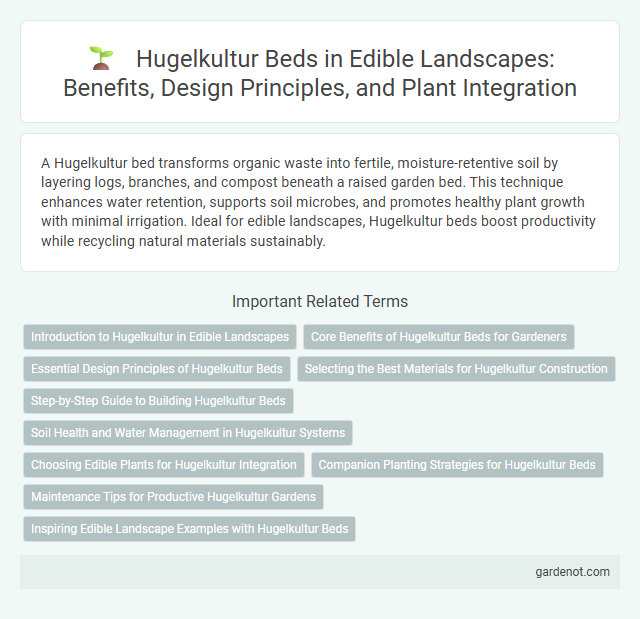A Hugelkultur bed transforms organic waste into fertile, moisture-retentive soil by layering logs, branches, and compost beneath a raised garden bed. This technique enhances water retention, supports soil microbes, and promotes healthy plant growth with minimal irrigation. Ideal for edible landscapes, Hugelkultur beds boost productivity while recycling natural materials sustainably.
Introduction to Hugelkultur in Edible Landscapes
Hugelkultur beds are raised garden beds built from decomposing wood and organic materials, creating nutrient-rich soil that retains moisture and improves aeration, ideal for edible landscapes. This permaculture technique enhances soil fertility naturally, reducing the need for irrigation and external fertilizers, making it sustainable for growing fruits, vegetables, and herbs. The elevated structure and organic matter decomposition also support diverse microbial activity, promoting healthy plant growth and long-term productivity.
Core Benefits of Hugelkultur Beds for Gardeners
Hugelkultur beds enhance soil fertility by decomposing wood and organic matter, which releases vital nutrients over time, fostering robust plant growth. These beds improve water retention through the porous structure of decaying logs, reducing irrigation needs and increasing drought resilience. Gardeners benefit from increased biodiversity and natural pest control, creating a sustainable and low-maintenance edible landscape.
Essential Design Principles of Hugelkultur Beds
Hugelkultur beds require essential design principles such as layering organic materials, starting with large logs or branches to create a moisture-retaining base that decomposes over time, enriching the soil naturally. Proper slope and shape ensure efficient water drainage and maximize sun exposure, promoting healthy plant growth while enhancing microclimate conditions. Incorporating diverse biomass including smaller twigs, leaves, and compost on top encourages biodiversity, soil aeration, and nutrient cycling, integral for a sustainable edible landscape.
Selecting the Best Materials for Hugelkultur Construction
Choosing the right materials for hugelkultur beds significantly impacts soil fertility and moisture retention in edible landscapes. Hardwood logs, preferably deciduous species like oak or maple, provide long-lasting carbon sources that slowly decompose, enriching the soil with nutrients. Supplementing with smaller branches, leaves, and compost ensures a balanced decomposition process, creating a nutrient-rich environment ideal for growing vegetables and herbs.
Step-by-Step Guide to Building Hugelkultur Beds
Start by selecting a suitable location with good drainage and sunlight for your hugelkultur bed. Layer decomposing wood, branches, and organic matter at the base, followed by nutrient-rich soil and compost on top to create a raised, moisture-retentive mound. Plant edible perennials and annuals adapted to this environment, ensuring proper watering during the initial establishment phase for optimal growth.
Soil Health and Water Management in Hugelkultur Systems
Hugelkultur beds enhance soil health by promoting nutrient cycling through the decomposition of wood layers, which increase organic matter and microbial activity. These raised garden beds improve water management by capturing and retaining moisture in the wood core, reducing irrigation needs during dry periods. The resulting soil structure supports robust root growth and sustains plant vitality in edible landscape systems.
Choosing Edible Plants for Hugelkultur Integration
Selecting edible plants for Hugelkultur beds requires considering species with strong root systems that thrive in well-drained, nutrient-rich soil created by decomposing wood. Perennial vegetables like asparagus, rhubarb, and artichokes integrate well, while herbs such as thyme and oregano benefit from the moisture-retentive characteristics of Hugelkultur. Incorporating nitrogen-fixing plants like peas and beans enhances soil fertility, supporting a sustainable edible landscape.
Companion Planting Strategies for Hugelkultur Beds
Companion planting strategies for Hugelkultur beds enhance soil fertility and pest management by pairing nitrogen-fixing plants like beans and peas with nutrient-demanding crops such as tomatoes and squash. Deep-rooted herbs like comfrey improve moisture retention and nutrient cycling within the raised mound structure of the Hugelkultur bed. Incorporating dynamic accumulators and beneficial flowers attracts pollinators and natural predators, optimizing the edible landscape's overall productivity.
Maintenance Tips for Productive Hugelkultur Gardens
Regularly monitor moisture levels in Hugelkultur beds to prevent drying out, especially during hot, dry periods, ensuring consistent plant growth. Incorporate seasonal organic mulch to support soil fertility and suppress weed growth, enhancing the bed's nutrient retention. Periodic addition of compost or well-rotted manure replenishes nutrients, maintaining a productive and balanced ecosystem within the Hugelkultur garden.
Inspiring Edible Landscape Examples with Hugelkultur Beds
Hugelkultur beds transform edible landscapes by creating nutrient-rich, moisture-retentive planting areas using decaying wood, branches, and organic matter as a raised bed foundation. These sustainable garden beds optimize soil fertility and water conservation, making them ideal for growing diverse fruits, vegetables, and herbs in permaculture designs. Examples from community gardens and urban farms demonstrate how hugelkultur beds boost productivity while enhancing biodiversity and resilience in edible landscapes.
Hügelkultur bed Infographic

 gardenot.com
gardenot.com